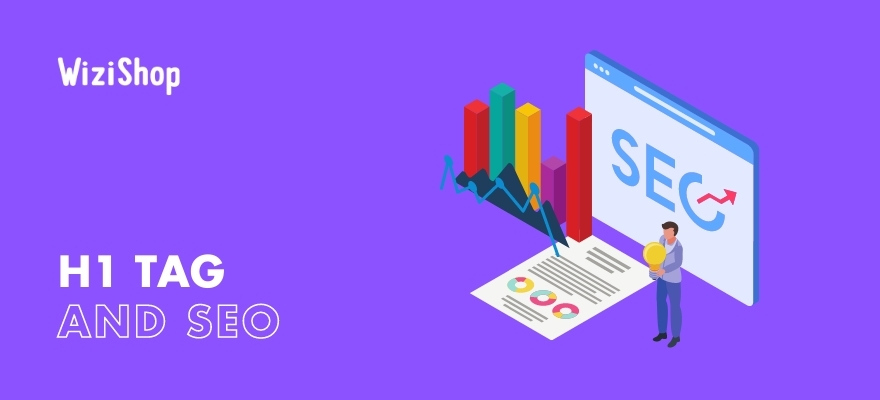To give your site the greatest chance of appearing as high as possible in Google search results, your site must respect certain SEO elements that are specific to the web.
One of them is the H1 tag.
This title tag is one of the headings that makes up the Hn markup, which is used to structure the information and is essential for SEO. Using it well will improve your SEO as well as the readability of your pages.
In this article, I explain what the H1 tag is and, especially, how to write it well and optimize it to improve your positioning in search engines.
What is the H1 tag?
Every web page is composed of a title and several subtitles or headings.
These are organized in levels from one to six, with level one being the most important and level six the least important.
Each title and subtitle is surrounded by tags ranging from H1 to H6. They’re used to structure the editorial content of an HTML page to make it more pleasant to read and create a hierarchy for it. They’re also known as “Hn tags.”
Discover our guide on heading tags.
In SEO, they are also used to provide semantic information and structure to the text.
The H1 title appears in the web browser tab. It’s one of the first things users see when they arrive on the page. It’s therefore very important because it gives the first bit of information on what the article contains.
H1 tag and SEO
In addition to your URL structure, meta description, and other items, the H1 tag is also very important for SEO, for various reasons.
First of all, it’s one of the first elements that the visitor discovers on your page. For this reason, it’s essential that you optimize it and work with it meticulously.
In addition, for search engines like Google, the weight given to the H1 tag is important. In other words, it’s by indicating your keyword in this tag that you’ll improve your chances of ranking in the results.
You must therefore include strategic keywords or expressions in the H1!
How do you write an optimized H1 tag?
Now that I’ve explained why the H1 tag is an essential element, I’ll give you some tips on how to write it well and make it even more effective in terms of SEO.
An H1 different from the title
First of all, I advise you to write a H1 tag that’s different from the title tag.
Discover our complete article on the title tag.
Even if nothing prevents you from using the exact same sentence for these two elements, differentiating them offers some advantages:
- The title tag has a limited size in the search engine results pages (SERPs). The H1 allows you to lengthen your title a little more without the risk of it being truncated.
- This allows you to optimize the long tail of the page by integrating more terms. Using synonyms increases the chances of being better optimized on Google.
One tag per page
When creating a website, it’s recommended to have one major idea per page.
To make the comparison with a book, for instance, how would you react if you had a book in your hands with several titles? You’d probably be feeling confused! Well, it’s exactly the same on the internet with the H1 tag.
A page evokes a single idea. It therefore only needs one main title.
H1 tag first on the page
In the same logic as using a single H1 tag per page, it’s better to place it at the top of the page. After all, it’s illogical to start a text with a subtitle and place its main title in the middle.
Let's take the example of a Word document. When you write a document, your main title is always placed first, at the top of the page. It’s then followed by other blocks of text between which are interspersed subheadings. Your webpage should follow exactly the same structure.
A highlighted tag
As the H1 tag alone summarizes all the content of your page, it must be a very visible element that the user can’t miss.
It must be the first thing that a user sees when arriving on your page. That’s why the success and effectiveness of an H1 tag doesn’t only depend on the choice of keywords.
In addition, think about enhancing this text through its formatting. For example, it’s better to use large text than a font that’s not very readable or too small.
To keep it simple, prioritize the following elements when creating H1 heading tags:
- a large font size;
- a clearly legible choice of font;
- a thick font with the use of bold;
- a centered H1 tag; and
- text that’s uncluttered and not hidden by other content.
An H1 that’s neither too short nor too long
Regarding the size, even if nothing is imposed by Google, it’s important to choose a title that’s neither too long nor too short when it comes to H1 heading tags on your website. The ideal length of the H1 tag is between 60 and 75 characters.
Of course, this length should be adapted according to your pages. For example, it’ll be difficult to reach this length with a product page.
H1 tags that are too short should be avoided for the following reasons:
- They aren’t enough to give the user a precise idea of the content of the page.
- They include fewer keywords and are therefore less effective for SEO.
H1s that are too long are also not effective because
- They aren’t sufficiently readable.
- They’re less impactful.
- That's simply not the role of the H1 tag. Everything else in your content is there to provide more details. Don’t put everything in the title!
A tag relevant to the content of the page
To optimize your H1 tag for SEO, it must describe the content of the page with precision. At a glance, users must understand if they’ll find the content that they’re looking for.
Here again, an example might help you to understand this concept more easily.
Imagine that you have a page on women’s swimwear. If you use the word “summer” in the H1, it may be difficult for the visitor to understand because it’s too general. On the other hand, if your title is “Women's swimwear for summer 2021,” it’s already much more relevant!
Your H1 heading tags must give a precise idea of what you offer, at a glance.
This catchphrase must be concise, but punchy, while being in line with what you offer your visitors.
An H1 that makes people want to read the article
Finally, the goal of your H1 tag should also be to make users want to read the rest of the page.
The idea is not to make them run away and redirect them to another site, quite the contrary. Your title must therefore arouse the reader’s curiosity and make them want to go further.
To do this, put yourself in your reader’s shoes. What’s the information that they’re looking for? What questions do they have?
Your H1 tag must attract readers and make them want to take the next step.
As you can see, the H1 tag is a central element of your page. It has an impact not only on SEO but also on the interest that visitors have in your pages.
Therefore, pay close attention to the tips mentioned above. By applying these different recommendations, your H1 tag will be really effective and will bring you results.
In contrast, poorly written and poorly used H1 headings can be totally counterproductive. So, take the time to think about it and refine this title, always with SEO in mind!










